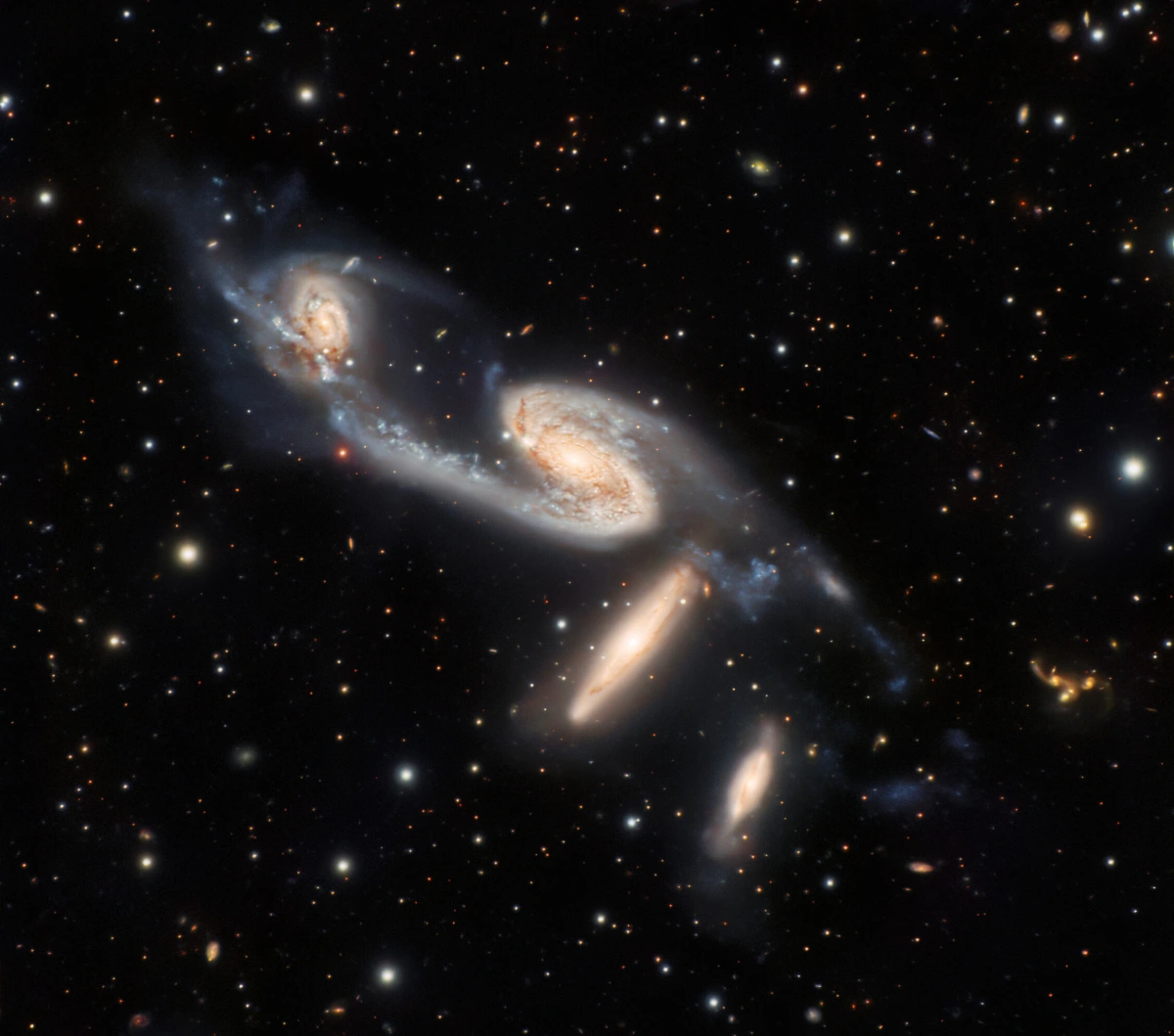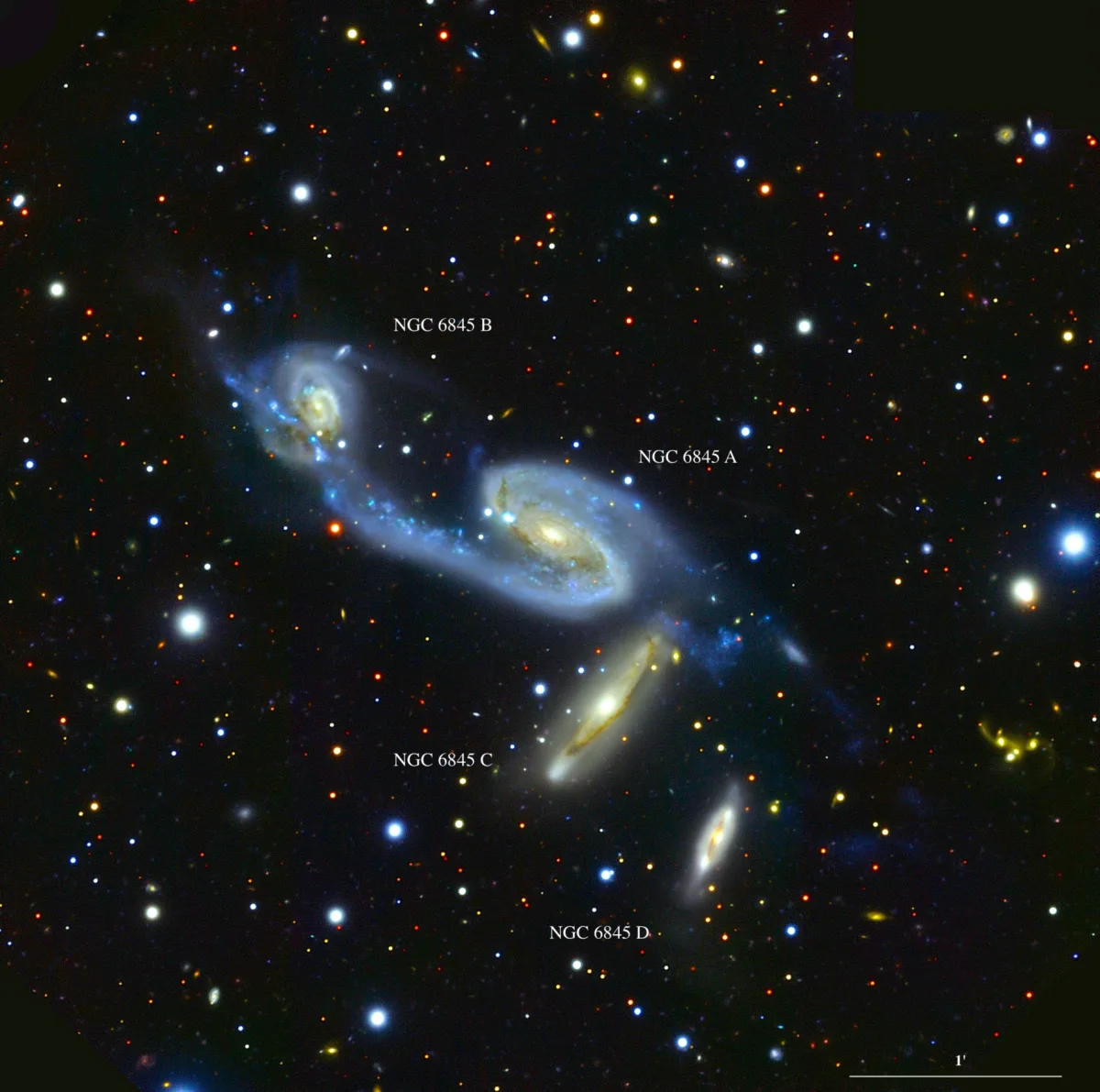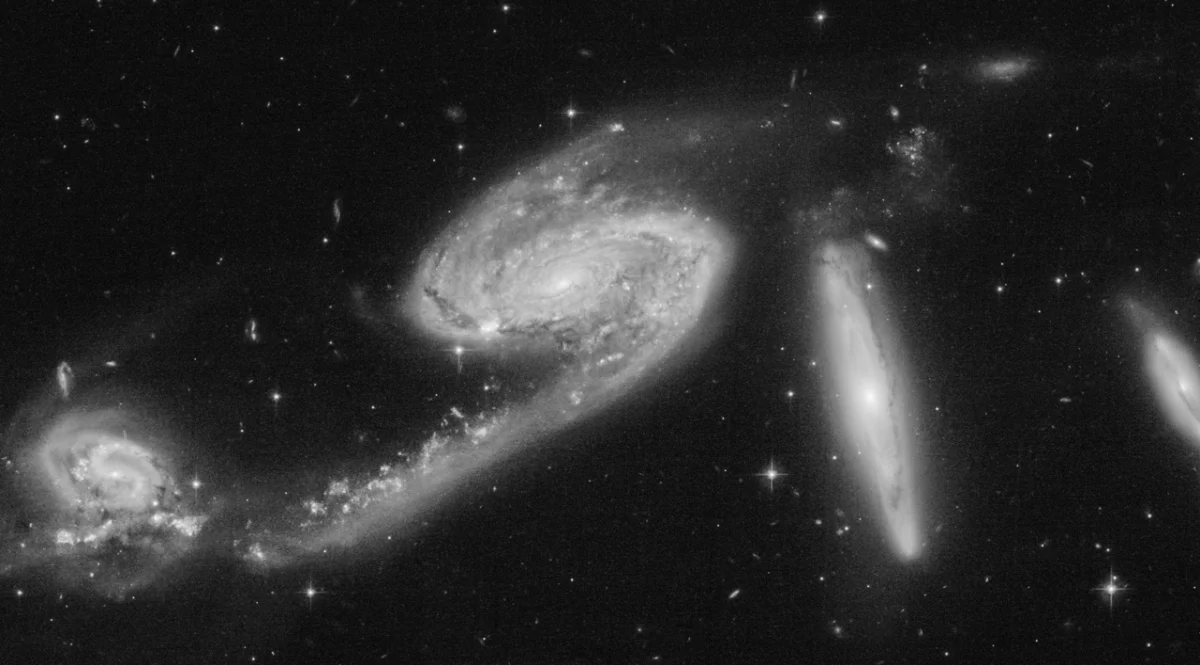NGC 6845 (Klemola 30) is a quartet of interacting galaxies located approximately 294 million light-years away in the constellation Telescopium. The group consists of two spiral galaxies and two lenticular galaxies. It is also known as the NGC 6845 Quartet or the NGC 6845 Group.
The four interacting galaxies are catalogued as NGC 6845A, NGC 6845B, NGC 6845C, and NGC 6845D. They appear roughly in a line. NGC 6845B and NGC 6845A lie in the northeast of the group, and NGC 6845C and NGC 6845D in the southwest. The group has a projected size of around 100 kiloparsecs (326,156 light-years).
The four galaxies look similar to the better-known Stephan’s Quintet in the constellation Pegasus, which also consists of four interacting galaxies (and a line-of-sight companion). However, unlike the galaxies in Stephan’s Quintet, not all members of NGC 6845 appear face-on.

A quartet of interacting galaxies is captured in this observation from Gemini South, which is one of the twin telescopes of the International Gemini Observatory, operated by NSF’s NOIRLab. The four galaxies in this image are collectively known as NGC 6845, and lie roughly 270 million light-years from Earth in a constellation named, appropriately, Telescopium. This constellation is one of a handful named after scientific instruments rather than animals or mythological figures. The galaxies in NGC 6845 come in two varieties: the pair of galaxies at the top of this image are well-defined spiral galaxies whereas the two below them are disk-shaped lenticular galaxies. Connecting the galaxies is evidence of star-forming regions and filaments made of stars detached from their original galaxies. Being relatively close neighbors, the galaxies in NGC 6845 are interacting. These gravitational interactions are subtly distorting the galaxies in NGC 6845, and astronomers believe that the two spiral galaxies will eventually evolve into lenticular galaxies. Image credit: International Gemini Observatory/NOIRLab/NSF/AURA/G. Gimeno, R. J. Díaz, H. Dottori; Image processing: T.A. Rector (University of Alaska Anchorage/NSF’s NOIRLab), M. Zamani (NSF’s NOIRLab) & D. de Martin (NSF’s NOIRLab) (CC BY-SA 4.0)
The galactic quartet occupies an area of 4 by 2 arcminutes in the sky. The galaxies have similar velocities, which suggests that they are physically close. They show clear evidence of strong tidal interaction, including many wisps and filaments and a bright tidal tail.
NGC 6845A (PGC 63985) is the brightest and largest galaxy in the group. It is a barred spiral galaxy with an apparent visual magnitude of 13.0 and an apparent size of 0.867 x 0.555 arcminutes. The galaxy contains a bright nuclear region with an active galactic nucleus (AGN) candidate and has H II regions at both ends of the bar.
The galaxy’s bright eastern arm extends towards NGC 6845B, forming a bridge between the two galaxies. Its fainter western arm extends to the southwest, passing the more distant galaxies NGC 6845C and NGC 6845D, and then loops back in the direction of the galaxy’s main body. NGC 6845A and NGC 6845B both show evidence of enhanced star formation rates, which is typical for interacting galaxies.
In 2024, observations of a luminous hinge clump (ID26) in NGC 6845 with the Gemini Multi Object Spectrograph (GMOS) revealed that the clump resides at the base of the northern tidal tail of NGC 6845A and has a star formation rate of 3.4 M⊙ yr−1, which is 15% of the total star formation rate of NGC 6845A.
Astronomers ruled out the possibility that the clump was a satellite galaxy because it has similar kinematics and metallicity as NGC 6845A. They proposed that it contains several stellar populations that formed in multiple bursts of star formation. The team found that the central region is ionized by shocks from stellar and supernova winds, which ionize the interstellar medium and can trigger bursts of star formation.
NGC 6845A has a smaller companion, the dwarf galaxy ATCA J2001-4659. The two galaxies are separated by about 4.4 minutes of arc. The dwarf galaxy is a member of the NGC 6845 galaxy group.
NGC 6845B (PGC 63986) is a compact spiral galaxy that appears almost face-on. It has an active galactic nucleus and is classified as a Seyfert 2 galaxy. The galaxy appears severely disrupted by the interaction with its larger neighbour. It has several filamentary extensions formed of material pulled out its main body as a result of the close encounter with NGC 6845A. Astronomers believe that NGC 6845A and NGC 6845B will eventually become lenticular galaxies.
NGC 6845C (PGC 63979) and NGC 6845D (PGC 63978) are both lenticular galaxies. They have apparent magnitudes of 14.4 and 15.4 and angular sizes of 0.853 x 0.273 and 0.383 x 0.176 arcminutes.
NGC 6845C has a very bright bulge. The galaxy’s nucleus has the highest surface brightness in the group. The galactic disk appears almost edge-on and has a faded spiral arm pattern.
NGC 6845D is the smallest of the four galaxies. The edge-on lenticular galaxy has a bright, distinctive nucleus and a ring-like structure in the disk. The outer portion of the disk is mildly warped on the northern side, in the direction of NGC 6845C.

NGC 6845, image: German Gimeno, Ruben J. Díaz, Horacio Dottori, Irapuan Rodrigues, and Damian Mast (CC BY-SA 4.0)
Facts
NGC 6845 was discovered by the English astronomer John Herschel on July 7, 1834.
Danish astronomer John Louis Emil Dreyer, who compiled the New General Catalogue (NGC), described the object as “very faint, small, very little extended, gradually a little brighter middle.”
The interacting system of four galaxies was first described in a proper motion survey by A. R. Klemola at Lick Observatory, California, in 1969. For this reason, the galaxy quartet is commonly referred to by the designation Klemola 30 (Klem 30). At the time of discovery, Klemola noted, “Nice compact group, dominated by bright (magnitude 13) one-armed spiral. At the end of the long arm appears either a large, bright detached part or a superposed galaxy of elongated form (magnitude 15). Also two fainter (magnitude 14 and 16) nearly edge-on spirals to SW of dominating spiral. Group deserves further study.”
NGC 6845A hosted a Type II supernova, SN 2008da, in June 2008. The supernova was observed with the Magellan I Baade telescope at Las Campanas Observatory in the Atacama Desert of Chile. Astronomers found an expansion velocity of 7,500 km/s.

Klemola 30 (NGC 6845), image: Judy Schmidt (CC BY 2.0)
Location
Klemola 30 lies in the faint southern constellation of Telescopium (the Telescope). It appears in the region between the feet of Sagittarius, marked by Arkab Prior and Arkab Posterior (Beta1 and Beta2 Sagittarii) and the Persian (Alpha Indi), the brightest star in the constellation Indus. The galaxies are too faint to be spotted in small and medium telescopes.

The location of Klemola 30 (NGC 6845), image: Stellarium
Klemola 30 – NGC 6845
| Constellation | Telescopium |
| Object type | Interacting galaxies |
| Right ascension | 20h 00m 59.0s |
| Declination | −47° 04′ 38″ |
| Apparent size | 2.92’ x 2.92’ |
| Distance | 294 million light-years (90 megaparsecs) |
| Redshift | 0.021441 |
| Names and designations | NGC 6845, NGC 6845 Quartet, NGC 6845 Group, Klemola 30, Klem 30, Str 1957-472 |
NGC 6845A
| Morphological type | SBb |
| Right ascension | 20h 00m 58.4278665624s |
| Declination | −47° 04′ 12.516466404″ |
| Apparent magnitude | 13.0 |
| Apparent size | 0.867’ x 0.555’ |
| Redshift | 0.021441 |
| Names and designations | NGC 6845A, PGC 63985, LEDA 63985, ESO 284-8, ESO-LV 284-0080, Ser 135-3, AM 1957-471, IRAS 19573-4712, IRAS F19573-4712, 2MASX J20005841-4704130, 6dFGS gJ200058.4-470413, PSCz Q19573-4712, QDOT B1957227-471224, SGC 195722-4712.5, SGC 195717-4713.9, Gaia DR3 6671670638463220992 |
NGC 6845B
| Morphological type | SBb |
| Right ascension | 20h 01m 05.2780236432s |
| Declination | −47° 03′ 33.861587040″ |
| Apparent magnitude | 14.1 |
| Apparent size | 0.483’ x 0.319’ |
| Distance | 294 million light-years (90 megaparsecs) |
| Redshift | 0.022526 |
| Names and designations | NGC 6845B, Klemola 30B, Klem 30B, PGC 63986, LEDA 63986, ESO-LV 284-0082, 6dFGS gJ200105.3-470334, FAUST 4549, 2MASX J20010526-4703340, SGC 195730-4711.9, Gaia DR2 6671670775904123392, Gaia DR3 6671670775904123392 |
NGC 6845C
| Morphological type | S0 |
| Right ascension | 20h 00m 56.8190638296s |
| Declination | −47° 05′ 03.594554304″ |
| Apparent magnitude | 14.4 |
| Apparent size | 0.853’ x 0.273’ |
| Distance | 294 million light-years (90 megaparsecs) |
| Redshift | 0.022792 |
| Names and designations | NGC 6845C, PGC 63979, LEDA 63979, ESO-LV 284-0081, 2MFGC 15260, 2MASX J20005684-4705040, SGC 195720-4713.3, Gaia DR3 6671670638463218304, 6dFGS gJ200056.8-470504 |
NGC 6845D
| Morphological type | S0-a |
| Right ascension | 20h 00m 53.5946272008s |
| Declination | −47° 05′ 42.964240236″ |
| Apparent magnitude | 15.4 |
| Apparent size | 0.383’ x 0.176’ |
| Distance | 294 million light-years (90 megaparsecs) |
| Redshift | 0.023868 |
| Names and designations | NGC 6845D, Klemola 30D, Klem 30D, PGC 63978, LEDA 63978, 2MASX J20005354-4705424, 6dFGS gJ200053.6-470543, Gaia DR3 6671670604103485824 |